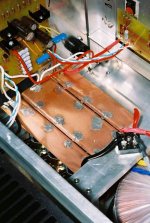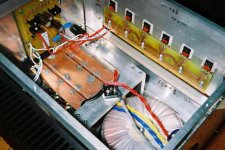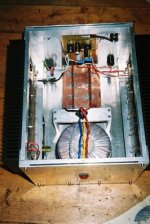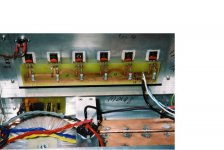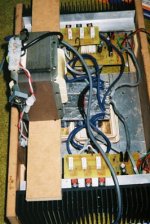Well Here is another Aleph 2 proect nearing completion.
Just a quick look before they are painted and engraved
It was a bit scary to start with, all the heat and power, but I'm getting use to it now! The pair of them take the chill off the room quite nicely!
As you can see I went for the rectangular aluminum chassis like many of the other Aleph 2 clones.
The design however evolved (with the help of my father - a retired engineer) is based on heat and size requirements for the internals and uses alumimium 3mm plate and L section, the heat sinks used tapped with M3 stainless bolts, the rest uses M4 stainless hardware.
The boxes measure 400mm long, 260mm high and 400 wide (incl heatsinks). My guess is they are about 28 KG in mass.
There are a couple of nice features, some venting at the sides using slots of about 4 x 400 mm above and below the heatsinks,and the lower box to enbles the power supply to benefit from the cooler air .
The heatsinks are Conrad 0.21C /watt and run at about 48C, the internal temperature in the upper chassis is about 43C and the lower chassis about 30C.
Most of the parts are stock Digi-key as you can see, the small caps are Silmics. The power supply uses E Bay NOS SAMHWA
8 x 15,000 uf 63 volt 85c which seem fine, with a 1KVA toroidal from Antrim and the Elector soft start circuit which is great. The transformers are a bit noisy at times due to mains born noise and their high flux, but with the lid on its quite reasonable.
The power supply uses 1mm copper sheet and in some areas I used teflon coated 20 amp silver plated standed cable. I after 1 hour or so warmup I have trimmed the bias for 3.00 amp with the lid on (using the blue trimmers) and have trimmed the current share for 50%.
I tried to keep the wiring to a minimum and with some symmetry to the layout. The project was an interesting and valuable journey, and certainly a valuable learning curve.
Please thanks to Mr Pass for his assistance and re assurance.
They perform very well and are appear very accurate and perhaps more so than Aleph 5 I made earlier, namely in the bass which is more defined and they also seem to have a more neutral and accurate tonal structure.
Cheers
macka
Just a quick look before they are painted and engraved
It was a bit scary to start with, all the heat and power, but I'm getting use to it now! The pair of them take the chill off the room quite nicely!
As you can see I went for the rectangular aluminum chassis like many of the other Aleph 2 clones.
The design however evolved (with the help of my father - a retired engineer) is based on heat and size requirements for the internals and uses alumimium 3mm plate and L section, the heat sinks used tapped with M3 stainless bolts, the rest uses M4 stainless hardware.
The boxes measure 400mm long, 260mm high and 400 wide (incl heatsinks). My guess is they are about 28 KG in mass.
There are a couple of nice features, some venting at the sides using slots of about 4 x 400 mm above and below the heatsinks,and the lower box to enbles the power supply to benefit from the cooler air .
The heatsinks are Conrad 0.21C /watt and run at about 48C, the internal temperature in the upper chassis is about 43C and the lower chassis about 30C.
Most of the parts are stock Digi-key as you can see, the small caps are Silmics. The power supply uses E Bay NOS SAMHWA
8 x 15,000 uf 63 volt 85c which seem fine, with a 1KVA toroidal from Antrim and the Elector soft start circuit which is great. The transformers are a bit noisy at times due to mains born noise and their high flux, but with the lid on its quite reasonable.
The power supply uses 1mm copper sheet and in some areas I used teflon coated 20 amp silver plated standed cable. I after 1 hour or so warmup I have trimmed the bias for 3.00 amp with the lid on (using the blue trimmers) and have trimmed the current share for 50%.
I tried to keep the wiring to a minimum and with some symmetry to the layout. The project was an interesting and valuable journey, and certainly a valuable learning curve.
Please thanks to Mr Pass for his assistance and re assurance.
They perform very well and are appear very accurate and perhaps more so than Aleph 5 I made earlier, namely in the bass which is more defined and they also seem to have a more neutral and accurate tonal structure.
Cheers
macka
Attachments
Hi Macka,
detail looks nice!
Maybe you could post a few more pictures showing the whole amp?
What power supply voltage/bias values are you using?
william
detail looks nice!
Maybe you could post a few more pictures showing the whole amp?
What power supply voltage/bias values are you using?
william
Sorry about the delay, I was trying to re size some pics when my My PC cracked it!
When I have the correct file images suitable for web pages I will post a series of images.
The volts are about +-44 to 45 volts, with bias @ 3amps which was done with the trimmer.
cheers
macka
When I have the correct file images suitable for web pages I will post a series of images.
The volts are about +-44 to 45 volts, with bias @ 3amps which was done with the trimmer.
cheers
macka
Attachments
Hi Macka,
Ive ordered Antrim too but they havent arrived yet. I ordered 35 0 35 1 KVA and was wondering what voltage you used?
Ive ordered Antrim too but they havent arrived yet. I ordered 35 0 35 1 KVA and was wondering what voltage you used?
Luke,
My transformers are 35+35 volts, that seems fine, but my mains voltage sags as much as 6% so I end up with anything from 43 - 45 DC, but I doubt if this really matters.
By the way here is a better internal shot, I'm getting the hang of this imaging software , called Photoimpact on a 7 day trial.
I forgot to mention earlier the boards are Wayne's, with the fet driver boards a slight re hash to fit my heatsinks.
The transformer is dwarfed by the chassis, but it is actual massive, about 175mm x 75mm and are around 8KG in mass.
The Fets are 244's from Allied Electronics in the US, they were quite reasonable, about US $1.80 each for memory and match to within 4.6 - 4.7 VGS.
The aluminium arch is to support the bridge and acts as a nice heatsink, it also allows for tidy wiring of the heavy solid secondary cables from the transformer. The transformers have parrell dual secondarys for the 1,000 va rating which is fine, but it made the soldering a pain in the ****, and I had to resort to an 80 watt iron. I have not tried 2 x bridges, with the Elector soft start they seem to survive.
I also found that by trying different, but closely matched 9610 input pairs, I was able to audibly improve the common mode rejection to the point where noise and hum is almost inaudible even with my ear up to the speakers. (just as per Aleph 60 & 30).
I have not bothered with RCA inputs as I am running the balanced output from the BOSOZ, the output is via Neutric Speakon connectors, which while expensive are superior to binding posts in my view, and safer.
I my only issue at the moment is the rubber feet, they tend to get sticky and leave marks on the JBL cabinets, I will have to replace them some nice aluminium/plastic types Farnel or Jaycar.
regards
macka
My transformers are 35+35 volts, that seems fine, but my mains voltage sags as much as 6% so I end up with anything from 43 - 45 DC, but I doubt if this really matters.
By the way here is a better internal shot, I'm getting the hang of this imaging software , called Photoimpact on a 7 day trial.
I forgot to mention earlier the boards are Wayne's, with the fet driver boards a slight re hash to fit my heatsinks.
The transformer is dwarfed by the chassis, but it is actual massive, about 175mm x 75mm and are around 8KG in mass.
The Fets are 244's from Allied Electronics in the US, they were quite reasonable, about US $1.80 each for memory and match to within 4.6 - 4.7 VGS.
The aluminium arch is to support the bridge and acts as a nice heatsink, it also allows for tidy wiring of the heavy solid secondary cables from the transformer. The transformers have parrell dual secondarys for the 1,000 va rating which is fine, but it made the soldering a pain in the ****, and I had to resort to an 80 watt iron. I have not tried 2 x bridges, with the Elector soft start they seem to survive.
I also found that by trying different, but closely matched 9610 input pairs, I was able to audibly improve the common mode rejection to the point where noise and hum is almost inaudible even with my ear up to the speakers. (just as per Aleph 60 & 30).
I have not bothered with RCA inputs as I am running the balanced output from the BOSOZ, the output is via Neutric Speakon connectors, which while expensive are superior to binding posts in my view, and safer.
I my only issue at the moment is the rubber feet, they tend to get sticky and leave marks on the JBL cabinets, I will have to replace them some nice aluminium/plastic types Farnel or Jaycar.
regards
macka
Attachments
matching the 244s
Just curious as to how many 244s you had to purchase to get the amount of matches you needed.
-Brian
Just curious as to how many 244s you had to purchase to get the amount of matches you needed.
-Brian
I like the sound.
Its more Hi Fi than the smaller brothers,
Meaning its more neutral and maybe a touch drier, so you can reaily here what's going on in the recording with better sound staging and its cleaner.
The Aleph 2 renders a perception of distant sounds being more well defined, you can easily hear even a small whisper in the distance while everthing else is happening upfront.
I think this is the real test if quality.
The bass really smacks of quality, its quite punchy, crisp and defined. On some recordings with a serious drum line it sounds so real your forget the speakers, but then I then I worry about the woman in the apartment below (who is a cop and already insane!) (due credit to the speakers here though).
As you can appreciate the speakers are quite sensitive (@96Dba) so even 10 watt peaks creates reasonable SPLs and the listening position.
The amps reach their full potential after about one hour, I think its because they get quieter. I get the impression they like to be driven a bit so I am waiting for free weekend when I can really ramp it up.
Perhaps the higher bias current and better components like the Silmics, Dales and Panasonic resisters make a diffference here too. The Fet's are also a slightly difference version, and perhaps they also impart a small impact as well. (I can just here Mr Pass chuckling in the background about the way we tinker his design using with so called high quality parts while worlds best practice goes out the window)
Everthing else seems to matter more now, so I am re building the passive crossovers for the speakers, so I can extract the most from the amps.
Like all things there are advances over time and I propose to make a small Aleph X down the track, if it has sufficient potential, I may re configure the Aleph 2 for X mode, I'm not sure at this point.
There were plenty of matches from 50 244s from Allied, but I asked from parts from the same batch, they were closer than the 240's.🙂
Cheers
macka
Its more Hi Fi than the smaller brothers,
Meaning its more neutral and maybe a touch drier, so you can reaily here what's going on in the recording with better sound staging and its cleaner.
The Aleph 2 renders a perception of distant sounds being more well defined, you can easily hear even a small whisper in the distance while everthing else is happening upfront.
I think this is the real test if quality.
The bass really smacks of quality, its quite punchy, crisp and defined. On some recordings with a serious drum line it sounds so real your forget the speakers, but then I then I worry about the woman in the apartment below (who is a cop and already insane!) (due credit to the speakers here though).
As you can appreciate the speakers are quite sensitive (@96Dba) so even 10 watt peaks creates reasonable SPLs and the listening position.
The amps reach their full potential after about one hour, I think its because they get quieter. I get the impression they like to be driven a bit so I am waiting for free weekend when I can really ramp it up.
Perhaps the higher bias current and better components like the Silmics, Dales and Panasonic resisters make a diffference here too. The Fet's are also a slightly difference version, and perhaps they also impart a small impact as well. (I can just here Mr Pass chuckling in the background about the way we tinker his design using with so called high quality parts while worlds best practice goes out the window)
Everthing else seems to matter more now, so I am re building the passive crossovers for the speakers, so I can extract the most from the amps.
Like all things there are advances over time and I propose to make a small Aleph X down the track, if it has sufficient potential, I may re configure the Aleph 2 for X mode, I'm not sure at this point.
There were plenty of matches from 50 244s from Allied, but I asked from parts from the same batch, they were closer than the 240's.🙂
Cheers
macka
- Status
- Not open for further replies.
- Home
- Amplifiers
- Pass Labs
- Aleph 2 Toaster
